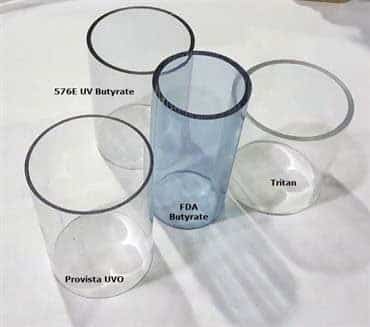Food

Provista and Tritan tubing have been used for conveying coffee beans, flour, grains, and other foods. We are delighted to be supplying The Roasting Plant with its new line of Provista (PETG) tubing. Their design team has been searching for a more aesthetic and functional tube for their coffee-bean pneumatic transport. Provista UVO not only has FDA, but also NSF compliance for food-safe tubing, with the addition of impact strength, crystal-clear clarity, and with an additional static dissipative coating.
We provided 40 bends, all on a 6″ Radius varying from 30 Deg to 130 Deg.
Find out more about our offerings at our Group 1 Tubing and Bends pages, or check out our Gallery page.
Our customers often ask us what grades of USFDA or NSF compliant food-safe tubing that we extrude for food contact.
Generally, for caps, closures, and cups, the FDA has not established compliance guidelines. Thus, UV stabilized butyrate (our formula 576E) is considered the standard. However, if you are interested in an FDA-approved material for specific contact with food, we have several materials to offer.
- FDA Butyrate: We have an FDA-approved butyrate formula that does not contain a UV stabilizer. It has a slight blue tint but is very clear and transparent.
- Provista: We also offer a UV-stabilized clear, transparent Provista tube. This resin is FDA-approved and NSF compliant. The extruded tube has exceptional clarity, but a moderately higher surface resistivity, and thus, a higher potential for static buildup. We do supply an additional static dissipative coating if the customer requests.
- Tritan: A co-polyester with temperature and impact resistance similar to polycarbonate.

Product Description
Under regulations administered by the U.S. Food and Drug Administration (FDA), various grades of Eastman cellulosic products may lawfully be used in food contact applications. These products are manufactured, stored, handled, and transported under conditions adhering to 21 CFR 174.5 on general provisions applicable to indirect food additives (i.e., current good manufacturing practices for food contact substances).
Tenite™ Cellulose Acetate Butyrate 264-10 has a plasticizer level of 10%. It meets FDA requirements for certain food-contact applications when supplied in specific FDA color numbers.
It is also noted for the same excellent balance of properties - toughness, hardness, strength, surface gloss, clarity, and a warm feel.
Performance Characteristics
- Formula 264 - base; complies with FDA food contact regulations when supplied in FDA color numbers.
- Proven UV Stability
- Long Term Weather resistance
- High Impact Resistance
- Strong Chemical Resistance
- Unlimited Color Ability
- The ability to be efficiently Foil Stamped or Silkscreened
- Easy to fabricate and machine
- Manufactured from a renewable resource
Product Description
Extruded Polyethylene Terephthalate Glycol (PETG) is a high-impact, FDA-approved thermoplastic co-polyester that provides toughness, chemical resistance and fabricates well. Due to its low forming temperature, PETG is readily heat-bent and can also be easily bonded using solvents. PETG can also be treated with a UVA inhibitor for inside or outside use while remaining FDA compliant. Busada PETG tubing has been used to convey coffee beans, flour, grains, other foods, paper cups, and containers pneumatically and chain conveyance.
PETG, like polycarbonate, is a thermoplastic or polymer that turns to liquid when heated and hardens to a very glassy state when cooled. PETG shares many characteristics with polycarbonate. They are highly impact-resistant, possess excellent clarity, and feature high light transmission rates (90% for PETG and 88% for Polycarbonate).
The most compelling reason to consider PETG over polycarbonate tubes is typically related to its lower cost. The outstanding degree of strength of PETG material makes using a lower gauge thickness possible within some applications. The consideration of this feature makes it possible to use less material, therefore, reducing costs to produce a product. In many circumstances, this is a determiner to selecting PETG as the alternative to polycarbonate. Additional attributes of PETG are its machinability and formability. Most drilling, sawing, and routing can be performed with standard woodworking equipment. Heat forming of the products in this group is a bonus.
Performance Characteristics
- Outstanding deep draw thermoforming
- High impact resistance
- Affordability
- Chemical resistant
- Easy to fabricate and machine
- Good clarity
Product Description
Eastman Tritan™ Copolyester TX 1800 is an amorphous copolyester specifically developed for blow molding and profile extrusion applications. Eastman Tritan™ Copolyester TX1800 may be used in repeated use food contact articles under the United States Food and Drug Administration (FDA) regulations.
Tritan is a new-generation clear plastic with excellent toughness and impact resistance. It is virtually unbreakable. Unlike some plastics, Tritan is made without bisphenol-A (BPA), and it retains clarity after repeated dishwasher washing cycles, without hazing or cracking. That makes bottles made with BPA-free Tritan more than reusable; it makes them a great sustainable alternative to a market looking to reduce landfill use.
With its unmatched clarity and durability, Tritan makes a lot of products in many markets better. Eastman Tritan™copolyester is fast becoming the material of choice over polycarbonate and other alternatives such as polypropylene, styrenes, and acrylics.
Tritan’s other sustainable advantages include:
- A favorable lifecycle assessment compared to other materials
- The opportunity to use less packaging than required with glass
- Reduced energy used in shipping because it’s much lighter than glass
- Other light-weighting efficiencies
Performance Characteristics
- FDA-approved for food contact
- Certified to NSF/ANSI Standard 51 for food equipment materials
- BPA and BPS-free
- Resistant to discoloration
- Glass-like clarity
- Outstanding impact resistance
- Dishwasher durability
- Unique sound damping properties compared with polycarbonate, glass, styrene-acrylonitrile (SAN) copolymers, and acrylics.
- Excellent hydrolytic stability
- Strong chemical resistance
- Strong heat resistance
- Does not impart any taste to the contents
- GREENGUARD Indoor Air Quality Certified®
